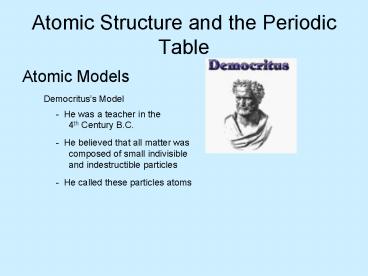Atomic Structure and the Periodic Table PowerPoint PPT Presentation
1 / 19
Title: Atomic Structure and the Periodic Table
1
Atomic Structure and the Periodic Table
- Atomic Models
Democrituss Model
- He was a teacher in the
- 4th Century B.C.
- He believed that all matter was
- composed of small indivisible
- and indestructible particles
- He called these particles atoms
2
Daltons Model 1. Elements are composed of tiny
indivisible particles
2. Atoms of the same element are identical
- Atoms of different elements can physically mix
together or - chemically combine in simple whole number ratios
- Chemical reactions occur when atoms are
separated, - joined, or rearranged
- Atoms of one element never change into atoms of
another - element
3
J. J. Thompsons Model
- He was an English Physicist
- He passes electric current through gases at low
pressure - using a cathode ray
- Negative particles were repelled by negative
plates and the positive - were attracted to the negative plates
- He was the first person to discover electrons
4
Rutherfords Model
http//www.shsu.edu/7Echm_tgc/sounds/pushmovies/l
2ruther.gif
- He found that the center of an atom is dense
and has a positive charge
- Most of the atom is made of empty space and in
that empty space - there are negative charges (the electrons)
5
Bohrs Model
- He found that the nucleus of an atom contains
protons and neutrons
- He also found that the electrons do not move
about randomly - outside the nucleus
- He believed that the electrons traveled in
paths he called Orbits
6
- The Quantum Mechanical Model
- The atomic model that is accepted today
- Protons and neutrons are still found in the
nucleus and the - electrons are outside the nucleus but the
electrons - are not found in orbits.
- Electrons occupy a space in which they are free
to move in called - an orbital
7
Basic Information About Atoms
Atoms are the smallest part of an element that
retains the properties of that element
We can now see atoms using a scanning tunneling
microscope
What are atoms made of?
Protons
- Have a charge of positive one
- Have a mass of 1 amu (atomic mass unit)
- Are located in the nucleus of an atom
Neutrons
- Are neutrally charged
- Have a mass of 1 amu
- Are located in the nucleus
8
Electrons
- Have a charge of negative one
- Are located outside of the nucleus in orbitals
- The have a mass of 1/1840 amu
- Are the only particles that can enter and
leave atoms
The nucleus takes up a very small part of the
space in an atom. - If an atom were the size of
a football stadium the nucleus would be the
size of a marble
9
Numbers derived from atoms and put on the
periodic table.
Atomic Number (Z) the number of protons in an
atom
- It is this different number of protons that
makes each element different
Mass Number the number of protons added to the
number of neutrons
- The number of electrons is not included
because they are so small
Every atom has a neutral charge because it has an
equal number of protons and electrons.
10
Short hand notation for writing the atomic mass
and atomic number
12 13 14
C C C
6 6 6
What is the difference between these three carbon
atoms. Is it a different number of protons,
neutrons, or electrons?
Isotopes atoms that have the same number of
protons but a different number of neutrons
(different mass numbers)
- Isotopes all have the same properties of that
specific element
11
Atomic Mass the average of all the masses of
isotopes of an element
- Is not a whole number like the mass of an
individual atom
- Atomic mass is based on the reference isotope
Carbon-12.
Atomic mass ?
Calculate the atomic mass of carbon if 2 of all
carbon is Carbon-14, 6 of all carbon is
Carbon-13, and 92 of all carbon is Carbon-12.
Atomic mass .02 14 amu .06 13 amu .92
12 amu 12.1 amu
12
Development of the Periodic Table
Mendeleev Constructed the first periodic table
according to the similarities in each elements
properties
- He arranged them in order of atomic masses
- He left blank spaces in his periodic table
because there were - no known elements with the appropriate properties
and masses.
13
Later Mosley rearranged the periodic table by
atomic number
The Modern Periodic Table
Periodic Law When elements are arranged in
order of atomic number, there is a repetition of
their physical and chemical properties
14
Groups or Families vertical columns. Group
numbers are indicated with a number and a
letter A or B
- Elements within a group have similar physical
and chemical properties
- Group A elements are the representative
elements - because they exhibit a wide range of chemical
- and physical properties
15
Where are things located on the
Periodic Table?
? Nonmetals
Metals ?
The light blue elements are semimetals
16
(No Transcript)
17
(No Transcript)
18
Properties of Metals
- They make up 80 of the elements
- All metals except for one is a solid at room
temperature
- One the big periodic table solids are black,
liquids are - blue, and gases are red
- They have a metallic luster
- They are good conductors of electricity
- They are malleable
- They are ductile
19
Properties of Nonmetals
- They lack luster
- They are brittle
- They are poor conductors of electricity
(insulators)
Properties of Semimetals
- They have some of the characteristics of metals
and some of - nonmetals

